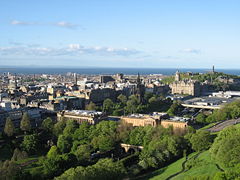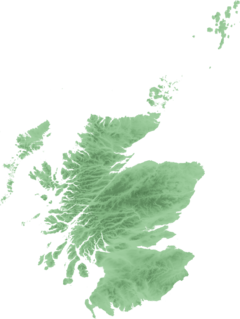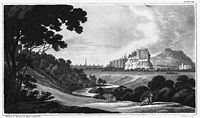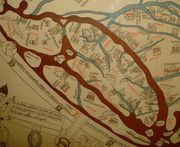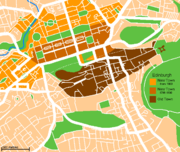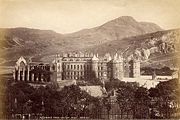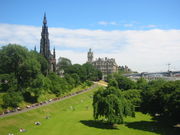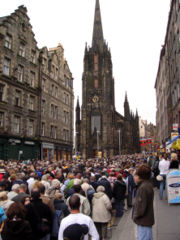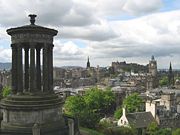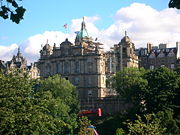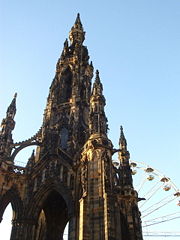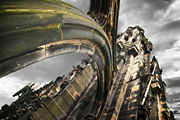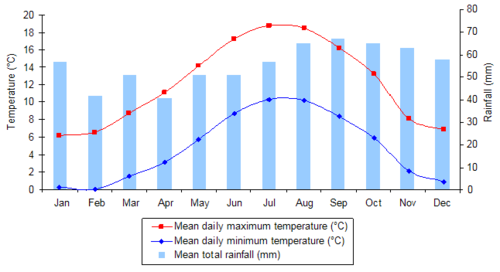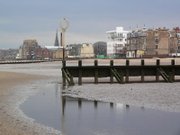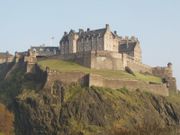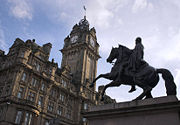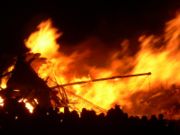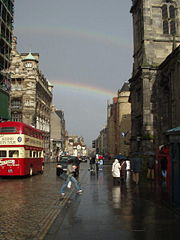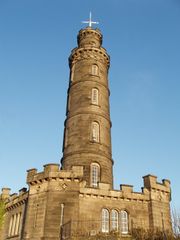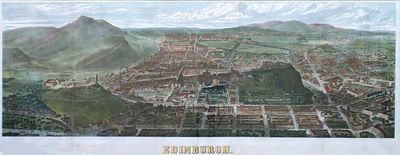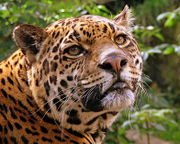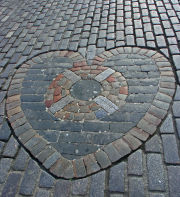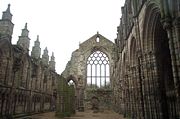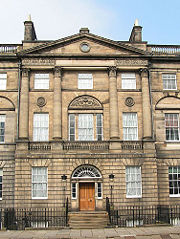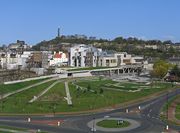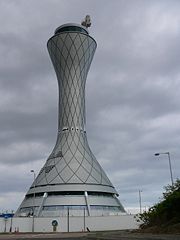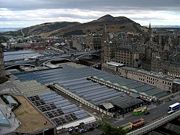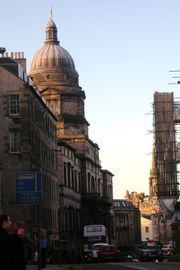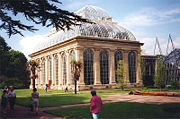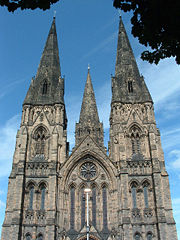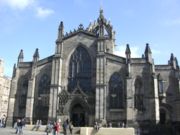Edinburgh
2008/9 Schools Wikipedia Selection. Related subjects: British Cities; Great Britain
| City of Edinburgh | |
| Scottish Gaelic: Dùn Èideann | |
| Scots: Edinburgh, Embra, Embro, Edinburrie | |
| Auld Reekie, Athens of the North | |
|
City of Edinburgh shown within Scotland |
|
| Area | 100 sq mi (259 km²) |
|---|---|
| Population | 448,624 ( 2001 Census) |
| Urban | 1,250,000 |
| OS grid reference | |
| - London | 332 miles (535 km) SSE |
| Council area | City of Edinburgh |
| Lieutenancy area | Edinburgh |
| Constituent country | Scotland |
| Sovereign state | United Kingdom |
| Post town | EDINBURGH |
| Postcode district | EH1-EH13; EH14 (part); EH15-EH17 |
| Dialling code | 0131 |
| Police | |
| Fire | |
| Ambulance | Scottish |
| European Parliament | Scotland |
| UK Parliament | Edinburgh South |
| Edinburgh West | |
| Edinburgh South West | |
| Edinburgh North and Leith Edinburgh East |
|
| Scottish Parliament | Edinburgh North and Leith |
| Edinburgh Central | |
| Edinburgh East and Musselburgh Edinburgh Pentlands Edinburgh South Edinburgh West Lothians |
|
| List of places: UK • Scotland | |
Coordinates:
Edinburgh (( listen), pronounced /ˈɛdɪnb(ə)rə/; Scottish Gaelic: Dùn Èideann) is the capital of Scotland and is its second largest city after Glasgow. It is one of Scotland's 32 local government council areas and is the seventh largest city in the United Kingdom.
Located in the south-east of Scotland, Edinburgh lies on the east coast of Scotland's Central Belt, along the Firth of Forth, near the North Sea. Owing to its rugged setting and vast collection of Medieval and Georgian architecture, including numerous stone tenements, it is often considered one of the most picturesque cities in Europe.
It forms the City of Edinburgh council area; the city council area includes urban Edinburgh and a 30-square-mile (78 km²) rural area.
It has been capital of Scotland since 1437 (replacing Scone) and is the seat of the Scottish Parliament. The city was one of the major centres of the Enlightenment, led by the University of Edinburgh, earning it the nickname Athens of the North. The Old Town and New Town districts of Edinburgh were listed as a UNESCO World Heritage Site in 1995. There are over 4,500 listed buildings within the city. In the census of 2001, Edinburgh had a total resident population of 448,625.
Edinburgh is well-known for the annual Edinburgh Festival, a collection of official and independent festivals held annually over about four weeks from early August. The number of visitors attracted to Edinburgh for the Festival is roughly equal to the settled population of the city. The most famous of these events are the Edinburgh Fringe (the largest performing arts festival in the world), the Edinburgh Comedy Festival (the largest comedy festival in the world), the Edinburgh International Festival, the Edinburgh Military Tattoo, the Edinburgh International Film Festival, and the Edinburgh International Book Festival.
Other notable events include the Hogmanay street party ( 31 December), Burns Night ( 25 January), St. Andrew's Day ( November 30), and the Beltane Fire Festival ( 30 April).
The city is one of Europe's major tourist destinations, attracting around 13 million visitors a year, and is the second most visited tourist destination in the United Kingdom, after London.
History
See Timeline of Edinburgh history
Edinburgh started as a fort named Castle Rock (an easily defended position). However, in the 7th century, England captured this location and named it Eiden's burgh (burgh is an old word for fort). In the 10th century, the Scots again recaptured this position. Then in the 12th century a small town flourished called Edinburgh.
Etymology
The origin of the city's name in English is understood to come from the Brythonic Din Eidyn (Fort of Eidyn) from the time when it was a Gododdin hillfort. In the 1st century the Romans recorded the Votadini as a Brythonic tribe in the area, and about AD 600 the poem Y Gododdin, using the Brythonic form of that name, describes warriors feasting "in Eidin's great hall".
It came to be known to the English, the Bernician Angles, as Edin-burh, which some people once believed derived from the Old English for "Edwin's fort", with a reference to the 7th century king Edwin of Northumbria. However, since the name apparently predates King Edwin, this is highly unlikely. The burgh element means "fortress" or "walled group of buildings", i.e. a town or city and is akin to the German burg, Latin parcus, Greek πύργος (pyrgos) etc. Burh is simply a translation of Brythonic Din; Edin is untranslated.
Other names
The city is affectionately nicknamed Auld Reekie ( Scots for Old Smoky), because when buildings were heated by coal and wood fires, chimneys would spew thick columns of smoke into the air. It has also been known as "Embray" or "Embro" as in Robert Garioch's Embro to the Ploy
Some have called Edinburgh the Athens of the North and Auld Greekie for its intellectual history, and for its topography, with the Old Town of Edinburgh performing a similar role to the Athenian Acropolis. Edinburgh is also known by several Latin names; Aneda or Edinensis, the latter can be seen inscribed on many educational buildings.
Edinburgh has also been known as Dunedin, deriving from the Scottish Gaelic, Dùn Èideann. Dunedin, New Zealand, was originally called "New Edinburgh" and is still nicknamed the "Edinburgh of the South". The Scots poets Robert Burns and Robert Fergusson sometimes used the city's Latin name, Edina. Ben Jonson described it as Britain's other eye, and Sir Walter Scott referred to the city as yon Empress of the North.
Areas
Areas of the centre
The historic centre of Edinburgh is divided into two by the broad green swath of Princes Street Gardens. To the south the view is dominated by Edinburgh Castle, perched atop the extinct volcanic crag, and the long sweep of the Old Town trailing after it along the ridge. To the north lies Princes Street and the New Town. The gardens were begun in 1816 on bogland which had once been the Nor Loch.
To the immediate west of the castle lies the financial district, housing insurance and banking buildings. Probably the most noticeable building here is the circular sandstone building that is the Edinburgh International Conference Centre.
Old Town
The Old Town has preserved its medieval plan and many Reformation-era buildings. One end is closed by the castle and the main artery, the Royal Mile, leads away from it; minor streets (called closes or wynds) lead downhill on either side of the main spine in a herringbone pattern. Large squares mark the location of markets or surround public buildings such as St Giles Cathedral and the Law Courts. Other notable places nearby include the Royal Museum of Scotland, Surgeons' Hall and McEwan Hall. The street layout is typical of the old quarters of many northern European cities, and where the castle perches on top of a rocky crag (the remnants of an extinct volcano) the Royal Mile runs down the crest of a ridge from it.
Due to space restrictions imposed by the narrowness of the "tail," the Old Town became home to some of the earliest "high rise" residential buildings. Multi-storey dwellings known as lands were the norm from the 1500s onwards with ten and eleven stories being typical and one even reaching fourteen stories. Additionally, numerous vaults below street level were inhabited to accommodate the influx of (mainly Irish) immigrants during the Industrial Revolution. These continue to fuel legends of an underground city to this day. Today there are tours of Edinburgh which take you into the underground city, which is being excavated.
New Town
The New Town was an 18th century solution to the problem of an increasingly crowded Old Town. The city had remained incredibly compact, confined to the ridge running down from the castle. In 1766 a competition to design the New Town was won by James Craig, a 22-year-old architect. The plan that was built created a rigid, ordered grid, which fitted well with enlightenment ideas of rationality. The principal street was to be George Street, which follows the natural ridge to the north of the Old Town. Either side of it are the other main streets of Princes Street and Queen Street. Princes Street has since become the main shopping street in Edinburgh, and few Georgian buildings survive on it. Linking these streets were a series of perpendicular streets. At the east and west ends are St. Andrew Square and Charlotte Square respectively. The latter was designed by Robert Adam and is often considered one of the finest Georgian squares in the world. Bute House, the official residence of the First Minister of Scotland, is on the north side of Charlotte Square.
Sitting in the glen between the Old and New Towns was the Nor' Loch, which had been both the city's water supply and place for dumping sewage. By the 1820s it was drained. Some plans show that a canal was intended, but Princes Street Gardens were created instead. Excess soil from the construction of the buildings was dumped into the loch, creating what is now The Mound. In the mid-19th century the National Gallery of Scotland and Royal Scottish Academy Building were built on The Mound, and tunnels to Waverley Station driven through it.
The New Town was so successful that it was extended greatly. The grid pattern was not maintained, but rather a more picturesque layout was created. Today the New Town is considered by many to be one of the finest examples of Georgian architecture and planning in the world.
South side
A popular residential part of the city is its south side, comprising a number of areas including Saint Leonards, Marchmont, Haymarket, Polwarth, Newington, Sciennes, The Grange, Bruntsfield, Morningside, and Merchiston. "South side" is broadly analogous to the area covered by the Burgh Muir, and grew in popularity as a residential area following the opening of the South Bridge. These areas are particularly popular with families (many well-regarded state and private schools are located here), students (the central University of Edinburgh campus is based around George Square just north of Marchmont and the Meadows, and Napier University has major campuses around Merchiston & Morningside), and with festival-goers. These areas are also the subject of fictional work: Ian Rankin's Inspector Rebus lives in Marchmont and worked in St Leonards; and Morningside is the home of Muriel Spark's Miss Jean Brodie. Today, the literary connection continues, with the area being home to the authors J. K. Rowling, Ian Rankin, and Alexander McCall Smith.
Leith
Leith is the port of Edinburgh. It still retains a separate identity from Edinburgh, and it was a matter of great resentment when, in 1920, the burgh of Leith was merged into the county of Edinburgh. Even today the parliamentary seat is known as 'Edinburgh North and Leith'. With the redevelopment of Leith, Edinburgh has gained the business of a number of cruise liner companies which now provide cruises to Norway, Sweden, Denmark, Germany and the Netherlands. Leith also has the Royal Yacht Britannia, berthed behind the Ocean Terminal as well as being home to Hibernian F.C..
Viewpoints
.
The varied terrain of the city includes several summits which command sweeping views over Edinburgh.
To the southeast of central Edinburgh stands the eminence known as Arthur's Seat, overlooking Holyroodhouse and the Old Town beside it. The crag is a collection of side vents of the main volcano on which Edinburgh is built. The volcano slipped and tipped sideways, leaving these vents as the highest points for kilometres around. Arthur's Seat is now part of Holyrood Park, originally owned by the monarch and part of the grounds of the Palace of Holyroodhouse. It contains the United Kingdom's largest concentration of geological SSSIs, as well as providing the people of Edinburgh with spectacular views of and from Arthur's Seat and somewhere to relax after a long day in the city. It is not surprising that it was in Edinburgh that James Hutton revolutionised scientific geology.
To the northeast, overlooking the New Town, is Calton Hill. It is topped by an assortment of buildings and monuments: two observatories, Nelson's Monument (a tower dedicated to Admiral Horatio Nelson), the old Royal High School (once almost the home of a devolved Scottish Assembly), and the unfinished National Monument, which is modelled on the Parthenon from the Athenian Acropolis and is nicknamed "Edinburgh's Disgrace". The nickname of the city, "Athens of the North", also hails partly from this monument. Calton Hill plays host to the Beltane Fire Festival on April 30 each year.
The Royal Observatory rests on Blackford Hill, the third and Southernmost viewpoint of the city.
Geography
Climate
Like much of the rest of Scotland, Edinburgh has a temperate maritime climate, which is relatively mild despite its northerly latitude. Winters are especially mild, considering that Moscow, Labrador and Newfoundland lie on the same latitude, with daytime temperatures rarely falling below freezing. Summer temperatures are normally moderate, with daily upper maxima rarely exceeding 22 °C. The proximity of the city to the sea mitigates any large variations in temperature or extremes of climate. Given Edinburgh's position between the coast and hills, it is renowned as a windy city, with the prevailing wind direction coming from the south-west which is associated with warm, unstable air from the Gulf Stream that can give rise to rainfall - although considerably less than cities to the west, such as Glasgow. Indeed, Edinburgh receives a lower annual precipitation total than most UK cities outside the south-east of England. Winds from an easterly direction are usually drier but colder. Rainfall is distributed fairly evenly throughout the year. Vigorous Atlantic depressions - sometimes called European windstorms can affect the city between October and March.
| Average / Month | Average | Jan | Feb | Mar | Apr | May | Jun | Jul | Aug | Sep | Oct | Nov | Dec |
|---|---|---|---|---|---|---|---|---|---|---|---|---|---|
| High temperature Celsius (°F) | 12.1 (53.8) | 6.2 (43.2) | 6.5 (43.7) | 8.7 (47.7) | 11.1 (52.0) | 14.2 (57.6) | 17.3 (63.1) | 18.8 (65.8) | 18.5 (65.3) | 16.2 (61.2) | 13.2 (55.8) | 8.7 (46.6) | 6.9 (44.4) |
| Low temperature Celsius (°F) | 4.8 (40.6) | 0.3 (32.5) | 0.0 (32.0) | 1.5 (34.7) | 3.1 (37.6) | 5.7 (42.3) | 8.7 (47.7) | 10.3 (50.5) | 10.2 (50.4) | 8.4 (47.1) | 5.9 (42.6) | 2.1 (35.8) | 0.9 (33.6) |
| Precipitation millimetres (in) | year: 668 (26.3) | 57 (2.24) | 42 (1.65) | 51 (2.01) | 41 (1.61) | 51 (2.01) | 51 (2.01) | 57 (2.24) | 65 (2.56) | 67 (2.64) | 65 (2.56) | 63 (2.48) | 58 (2.28) |
| Number of rain days | year: 182.8 | 17.2 | 13.6 | 16.2 | 14.0 | 14.4 | 13.3 | 13.1 | 15.2 | 16.5 | 16.7 | 16.3 | 16.3 |
| Source: World Meteorological Organization | |||||||||||||
Demographics
As of 2006, the General Register Office for Scotland estimated that the City of Edinburgh council area had a resident population of 463,510. The 2001 UK census reported the population to be 448,624, making the city the seventh largest in the United Kingdom. The General Register Office also reported that this resident population was split between 220,094 males and 237,736 females.
Though Edinburgh's population is ageing, a very large and transient population of young students studying at the city universities has helped to offset this demographic problem. There are estimated to be around 100,000 students studying at the various institutions of higher education in the city.
The population of the greater Edinburgh area (including parts of Fife and the Scottish Borders) is 1.25 million and is projected to grow to 1.33 million by 2020. City of Edinburgh Council hopes this will continue to grow to 1.5 million by 2040, which is in line with the current average population of the three leading city regions in northern Europe: Stockholm, Helsinki and Oslo.
| Year | 1755 | 1791 | 1811 | 1831 | 1851 | 1871 | 1891 | 1911 | 1931 | 1951 | 1971 | 1991 | 2001 | 2006 |
|---|---|---|---|---|---|---|---|---|---|---|---|---|---|---|
| Population | 57,195 | 81,865 | 82,624 | 136,054 | 160,511 | 196,979 | 261,225 | 320,318 | 439,010 | 466,761 | 453,575 | 418,914 | 448,624 | 463,510 |
| Source: City of Edinburgh Council and Edinphoto | ||||||||||||||
Geology
Some 350 and 400 million years ago, the cores of several volcanic vents in the area cooled and solidified to form tough basalt volcanic plugs. Later, during the last ice age, glaciers moving from west to east eroded the area to its current conformation. Louis Agassiz, who first proposed the scientific theory of ice ages, used evidence from Blackford Glen to support the theory.
Old Town
Castle Rock is one such plug, which during ice ages sheltered the softer rock to the east forming a mile-long tail of material to the east, creating a distinctive crag and tail formation. This structure, along with a ravine to the south and a swampy valley to the north, formed an ideal natural fortress and recent excavations found material dating back to the Late Bronze Age, around 850 BC.
Over the last few hundred years, the area occupied by this geological feature has come to be known as the Old Town. Edinburgh Castle stands on the crag, and the Royal Mile follows the narrow crest of the steep-sided tail, descending from the castle to meet general ground level at Holyrood Palace. The Grassmarket and Cowgate run east–west through the ravine to the south, while the swamp of the Nor Loch has now been drained to form Princes Street Gardens, and accommodates Edinburgh Waverley railway station.
Arthur's Seat
Like the castle rock on which Edinburgh Castle is built, Arthur's Seat was formed by an extinct volcano system of the Carboniferous period, which was eroded by a glacier moving from west to east during the Quaternary, exposing rocky crags to the west and leaving a tail of material swept to the east. This is how the Salisbury Crags formed and became teschenite cliffs between Arthur's Seat and the city centre.
Culture
Festivals
Culturally, Edinburgh is best known for the Edinburgh Festival, although this is in fact a series of separate events, which run from the end of July until early September each year. The longest established festival is the Edinburgh International Festival, which first ran in 1947. The International Festival centres on a programme of high-profile theatre productions and classical music performances, featuring international directors, conductors, theatre companies and orchestras.
The International Festival has since been taken over in both size and popularity by the Edinburgh Fringe. What began as a programme of marginal acts has become the largest arts festival in the world, with 1867 different shows being staged in 2006, in 261 venues. Comedy is now one of the mainstays of the Fringe, with numerous notable comedians getting their 'break' here, often through receipt of the Perrier Award.
In 2008 comedy on the Edinburgh Fringe was launched as a festival within a festival, and labelled the Edinburgh Comedy Festival. Already at its inception it was the largest comedy festival in the world.
Alongside these major festivals, there is also the Edinburgh Art Festival, Edinburgh International Film Festival, the Edinburgh Jazz and Blues Festival, and the Edinburgh International Book Festival. T on the Fringe, a popular music offshoot of the Fringe, began in 2000, replacing the smaller Flux and Planet Pop series of shows. Tigerfest is an independent music festival which ran concurrently with the Fringe in 2004 and 2005 before moving to a May slot in 2006.
Running concurrently with the summer festivals, the Edinburgh Military Tattoo occupies the Castle Esplanade every night, with massed pipers and fireworks.
The Edinburgh International Science Festival is held annually in April and is one of the most popular science festivals in the world.
Celebrations
Equally famous is the annual Hogmanay celebration. Originally simply a street party held on Princes Street and the Royal Mile, the Hogmanay event has been officially organised since 1993. In 1996, over 300,000 people attended, leading to ticketing of the main street party in later years, with a limit of 100,000 tickets. Hogmanay now covers four days of processions, concerts and fireworks, with the actual street party commencing on New Years Eve. During the street party Princes Street is accessible only by ticket holders, and tickets are available for a £5 administration fee. This ticket allows access into Princes Street where there are live bands playing, food and drink stalls, and a clear view of the castle and fireworks. Alternative tickets are available for entrance into the Princes Street Gardens concert and Ceilidh for around £40, where well known artists perform live and ticket holders are invited to participate in some traditional Scottish Ceilidh dancing. The event attracts thousands of people from all over the world. On the night of 30 April, the Beltane Fire Festival takes place on Edinburgh's Calton Hill. The festival involves a procession followed by the re-enactment of scenes inspired by pagan spring fertility celebrations.
Museums and libraries
Edinburgh is home to a large number of museums and libraries, especially ones that are considered the main national institutions, the most important are the Museum of Scotland, the Royal Museum, the National Library of Scotland, National War Museum of Scotland, the Museum of Edinburgh, Museum of Childhood and the Royal Society of Edinburgh.
Literature and philosophy
Edinburgh has a long literary tradition, going back to the Scottish Enlightenment. Edinburgh's Enlightenment produced philosopher David Hume and the pioneer of economics, Adam Smith. Writers such as James Boswell, Robert Louis Stevenson, Sir Arthur Conan Doyle, and Sir Walter Scott all lived and worked in Edinburgh. J K Rowling, author of the Harry Potter novels, is a resident of Edinburgh. Edinburgh has also become associated with the crime novels of Ian Rankin; and the work of Leith native Irvine Welsh, whose novels are mostly set in the city and are often written in colloquial Scots. Edinburgh is also home to Alexander McCall Smith and a number of his book series. Edinburgh has also been declared the first UNESCO City of Literature.
Music, theatre and film
Outside festival season, Edinburgh continues to support a number of theatres and production companies. The Royal Lyceum Theatre has its own company, while the King's Theatre, Edinburgh Festival Theatre, and Edinburgh Playhouse stage large touring shows. The Traverse Theatre presents a more contemporary programme of plays. Amateur theatre companies productions are staged at the Bedlam Theatre, Church Hill Theatre, and the King's Theatre amongst others.
The Usher Hall is Edinburgh's premier venue for classical music, as well as the occasional prestige popular music gig. Other halls staging music and theatre include The Hub, the Assembly Rooms and the Queen's Hall. The Scottish Chamber Orchestra is based in Edinburgh.
Edinburgh has two repertory cinemas, the Edinburgh Filmhouse, and the Cameo, and the independent Dominion Cinema, as well as the usual range of multiplexes.
Edinburgh has a healthy popular music scene. Occasional large gigs are staged at Murrayfield, The Liquid Room, Meadowbank, and the Edinburgh Corn Exchange.
Edinburgh is also home to a flourishing group of contemporary composers such as Nigel Osborne, Peter Nelson, Lyell Cresswell, Haflidi Hallgrimsson, Edward Harper, Robert Crawford, Robert Dow, and John McLeod whose music is also heard regularly on BBC Radio 3 and throughout the UK.
Edinburgh's underground music scene is also vibrant with many creative bands and solo electronica artists experimenting with new sounds and rhythms such as digitalTRAFFIC ( http://www.digitaltraffic.biz).
Visual arts
Edinburgh is home to Scotland's five National Galleries. The national collection is housed in the National Gallery of Scotland, located on the Mound, and now linked to the Royal Scottish Academy, which holds regular major exhibitions of painting. The contemporary collections are shown in the Scottish National Gallery of Modern Art, and the nearby Dean Gallery. The Scottish National Portrait Gallery focuses on portraits and photography.
The council-owned City Arts Centre shows regular art exhibitions. Across the road, The Fruitmarket Gallery offers world class exhibitions of contemporary art, featuring work by British and international artists with both emerging and established international reputations.
Edinburgh is also home to several of Scotland’s galleries and organisations dedicated to contemporary visual art. Significant strands of this infrastructure include: The Scottish Arts Council, Inverleith House, Edinburgh College of Art, Talbot Rice Gallery (University of Edinburgh), The Travelling Gallery, Edinburgh Printmakers, WASPS, Artlink, Edinburgh Sculpture Workshop, Doggerfisher, Stills, Collective Gallery, Out of the Blue, The Embassy, Magnifitat, Sleeper, Total Kunst, OneZero, Standby, Portfolio Magazine, MAP magazine, Edinburgh's One O'Clock Gun Periodical and Product magazine and the Edinburgh Annuale.
c
Nightlife
Edinburgh has a large number of pubs, clubs and restaurants. The traditional areas were the Grassmarket, Lothian Road and surrounding streets, Rose Street and its surrounds and the Bridges. In recent years George Street in the New Town has grown in prominence, with a large number of new, upmarket public houses and nightclubs opening, along with a number on the parallel Queen Street. Stockbridge and the waterfront at Leith are also increasingly fashionable areas, with a number of pubs, clubs and restaurants.
Like many other cities in the UK, Edinburgh has numerous nightclubs that play popular and chart music. The underground nightclub scene playing music such as Techno, House, Electronica and Drum & Bass however has suffered in recent years with the closure of Wilkie House, The Venue, La Belle Angele (burned in a fire) and The Honeycomb (recently reopened as The Hive). Opium is Edinburgh's only dedicated rock music club, playing all music from the rock spectrum. The Citrus Club, The Hive, and Studio 24 also hold nights dedicated to rock music. Stereo, Cabaret Voltaire, City, Lava/Ignite and The Liquid Room are the main nightclub venues in the city.
A fortnightly publication, The List, is dedicated to life in Edinburgh and around, and contains listings of all Nightclubs, as well as music, theatrical and other events. The List also regularly produces specialist guides such as its Food and Drink guide and its guide to the Edinburgh Festivals. There are also many competing magazines that can be found for free such as Flash Edinburgh, Gig Guide and The Skinny.
Edinburgh Zoo
Edinburgh Zoo is a non-profit zoological park located in Corstorphine. The land lies on the Corstorphine Hill, provides extensive views of the city. Built in 1913, and owned by the Royal Zoological Society of Scotland, it receives over 600,000 visitors a year, which makes it Scotland's second most popular paid-for tourist attraction, after Edinburgh Castle. As well as catering to tourists and locals, the Zoo is involved in many scientific pursuits, such as captive breeding of endangered animals, researching into animal behaviour, and active participation in various conservation programs around the world. The Zoo is the only zoo in Britain to house polar bears and koalas, as well as being the first zoo in the world to house and to breed penguins.
Shopping
Edinburgh has a wide variety of shops, from upmarket department stores to a vast array of charity shops in Stockbridge. Princes Street plays host to an extremely wide range of stores, from "pound-shops" to Jenners. Most of the national-level chain stores such as Boots and New Look are located in the "uptown" district of Princes Street. Multrees Walk makes up the upmarket shopping district in Edinburgh- with Harvey Nichols anchoring the development. Multrees Walk includes brands such as Louis Vuitton, Emporio Armani, Mulberry and Calvin Klein. The street leads on to the St. James' Centre, which caters in discount clothing, homewares and books as well as hosting the Edinburgh branch of the upscale department store chain, John Lewis.
Sport
Football
Edinburgh has two professional football clubs: Hibernian and Heart of Midlothian. They are known locally as Hibs and Hearts. Both teams currently play in the Scottish Premier League: Hibernian at Easter Road Stadium, which straddles the former boundary between Edinburgh and Leith and Hearts at Tynecastle Stadium in Gorgie.
Edinburgh was also home to senior sides St Bernard's, Ferranti Thistle F.C. and most recently, Meadowbank Thistle until 1995, when the club moved to Livingston, shedding their old name and becoming Livingston F.C.. The Scottish national team has played some friendly matches at Easter Road and Tynecastle.
Non-league sides include Spartans and Edinburgh City, who play in the East of Scotland League along with Civil Service Strollers F.C., Lothian Thistle F.C., Edinburgh University A.F.C., Edinburgh Athletic F.C., Tynecastle F.C., Craigroyston F.C. and Heriot-Watt University F.C.. There is one team who plays in the Scottish Junior Football Association, East Region: Edinburgh United F.C..
Other sports
The Scotland national rugby union team plays at Murrayfield Stadium, which is owned by the Scottish Rugby Union and is also used as a venue for other events, including music concerts. Edinburgh's professional rugby team, Edinburgh Rugby, play in the Celtic League at Murrayfield. It is the largest capacity stadium in Scotland. Raeburn Place is notable for holding the first rugby international game between Scotland and England.
The Scottish cricket team, who represent Scotland at cricket internationally and in the C&G Trophy, play their home matches at The Grange in Stockbridge.
The Edinburgh Capitals are the latest of a succession of ice hockey clubs to represent the Scottish capital. Previously Edinburgh was represented by the Murrayfield Racers and the Edinburgh Racers. The club play their home games at the Murrayfield Ice Rink and are the sole Scottish representative in the Elite Ice Hockey League.
The Edinburgh Diamond Devils is a baseball club claiming its first Scottish Championship in 1991 as the "Reivers." 1992 saw the team repeat as national champions, becoming the first team to do so in league history and saw the start of the club's first youth team, the Blue Jays. The name of the club was changed in 1999.
Edinburgh has also hosted various national and international sports events including the World Student Games, the 1970 British Commonwealth Games, the 1986 Commonwealth Games and the inaugural 2000 Commonwealth Youth Games. For the Games in 1970 the city built major Olympic standard venues and facilities including the Royal Commonwealth Pool and the Meadowbank Stadium.
In American football, the Scottish Claymores played WLAF/ NFL Europe games at Murrayfield, including their World Bowl 96 victory. From 1995 to 1997 they played all their games there, from 1998 to 2000 they split their home matches between Murrayfield and Glasgow's Hampden Park, then moved to Glasgow full-time, with one final Murrayfield appearance in 2002. The city's most successful non-professional team are the Edinburgh Wolves who currently play at Meadowbank Stadium.
The Edinburgh Marathon has been held in the city since 1999 with more than 13,000 taking part annually.
Edinburgh has a speedway team, the Edinburgh Monarchs, which currently is based at the Lothian Arena in Armadale, West Lothian. They have operated there since 1997. Speedway was introduced to Edinburgh at the Marine Gardens Stadium in Seafield Road and it operated 1928–31 and 1938–39. The Edinburgh team of 1930 operated in the Northern League. In 1948 speedway returned to the city at Old Meadowbank. The Monarchs operated there 1948–54 as members of the National League Division Two. Training events were staged at Old Meadowbank occasionally from 1957–59. Two Students Charities events were staged one in 1959 and the other in 1960. Between 1960–67 the Monarchs were members of the Provincial League and from 1965 members of the British League. Following a 10-year gap the Monarchs returned to Powderhall Stadium and raced there 1977–95. A training track operated at the Gyle in the late 1960s. Between 1949 and 1951 Edinburgh was the home track of Australian rider Jack Young who won the World Championship in 1951.
The Honourable Society of Edinburgh Boaters, Scotland's only punting society, used to ply the waters of the Union Canal from a base at Hermiston House. The Society staged several regattas and engaged in the annual Scottish Boat Race against Cambridge University Dampers Club with mixed success.
Economy
Edinburgh has the strongest economy of any city in the UK outside London. The strength of Edinburgh's economy is reflected by its GDP per capita, which was measured at £27,600 (€40,700, $55,000) in 2004. The economy of Edinburgh and its hinterland has recently been announced as one of the fastest growing city regions in Europe. Education and health, finance and business services, retailing and tourism are the largest employers. The economy of Edinburgh is largely based around the services sector — centred around banking, financial services, higher education, and tourism. Unemployment in Edinburgh is low at 2.2%, which has been consistently below the Scottish average.
Banking has been a part of the economic life of Edinburgh for over 300 years with the invention of capitalism in the city, with the establishment of the Bank of Scotland by an act of the original Parliament of Scotland in 1695. Their headquarters are on the Mound, overlooking Princes Street. Today, together with the burgeoning financial services industry, with particular strengths in insurance and investment underpinned by the presence of Edinburgh based firms such as Scottish Widows and Standard Life, Edinburgh has emerged as Europe’s sixth largest financial centre. The Royal Bank of Scotland, which is the fifth largest in the world by market capitalisation, opened their new global headquarters at Gogarburn in the west of the city in October 2005; their registered office remains in St. Andrew Square.
Manufacturing has never had as strong presence in Edinburgh compared with Glasgow; however brewing, publishing, and nowadays electronics have maintained a foothold in the city. While brewing has been in decline in recent years, with the closure of the McEwan's Brewery in 2005, Caledonian Brewery remains as the largest, with Scottish and Newcastle retaining their headquarters in the city.
Tourism is an important economic mainstay in the city. As a World Heritage Site, tourists come to visit such historical sites as Edinburgh Castle, the Palace of Holyroodhouse and the Georgian New Town. This is augmented in August of each year with the presence of the Edinburgh Festivals, which bring in large numbers of visitors, generating in excess of £100m for the Edinburgh economy.
As the centre of Scotland’s devolved government, as well as its legal system, the public sector plays a central role in the economy of Edinburgh with many departments of the Scottish Government located in the city. Other major employers include NHS Scotland and local government administration.
Edinburgh has seventy post offices, one in St. Mary's Street (in the Old Town close to Waverley Station) is "central", in that it is the only one within the EH1 1 postcode zone, but the Royal Mail sorting office at 10 Brunswick Road has the latest collection. Edinburgh's General Post Office building, in Waterloo Place, no longer houses a post office, which has been moved into the nearby St. James' Centre. The façades of the Waterloo Place building still stand, but the interior has been removed and replaced with offices.
Government and politics
As capital of Scotland, Edinburgh is host to the national unicameral legislature, the Scottish Parliament. The Scottish Parliament Building, in the Holyrood area of Edinburgh, opened in September 2004.
The devolved Scottish Government has offices at St Andrew's House on Calton Hill in the city centre, and Victoria Quay in Leith. Bute House on Charlotte Square is the official residence of the First Minister of Scotland.
The city has hosted a number of international events, such as Commonwealth Heads of Government Meeting and the Council of Europe.
Apart from elections to the Scottish Parliament, politics in Edinburgh are evident in elections to the City of Edinburgh Council and the House of Commons of the Parliament of the United Kingdom. For elections to the European Parliament, Edinburgh is within the Scotland constituency.
Local government
Edinburgh constitutes one of the 32 council areas of Scotland and, as such, is represented by the City of Edinburgh Council, a local authority composed of 58 elected councillors, each representing a multi-member electoral ward in the city. The council is led by the Lord Provost.
The Liberal Democrats and Scottish National Party jointly run the council in a coalition. The Lord Provost of Edinburgh, George Grubb (who replaced Lesley Hinds on May 16, 2007), and the Leader of the Council, Jenny Dawe, are both Liberal Democrat Party members.
Elections to the council are held on a four year cycle, the last on 3 May 2007. Councillors are elected from multi-member wards, each electing three or four councillors by the single transferable vote system, to produce a form of proportional representation.
Boundaries date from 2007.
Scottish Parliament
In elections to the Scottish Parliament ( Holyrood), the city area is divided between six of the nine constituencies in the Lothians electoral region. Each constituency elects one Member of the Scottish Parliament (MSP) by the first past the post system of election, and the region elects seven additional MSPs, to produce a form of proportional representation.
Five of the six Edinburgh constituencies, Edinburgh North and Leith, Edinburgh Central, Edinburgh Pentlands, Edinburgh South and Edinburgh West, are entirely within the city area. Musselburgh, in East Lothian, is included in the sixth, Edinburgh East and Musselburgh.
Boundaries date from 1999, and the creation of the Scottish Parliament itself.
Parliament of the United Kingdom
In elections to the House of Commons of the Parliament of the United Kingdom (Westminster), the city area is divided between five first past the post constituencies, all entirely within the city area, and each electing one Member of Parliament (MP): Edinburgh South, Edinburgh West, Edinburgh South West, Edinburgh North and Leith, and Edinburgh East.
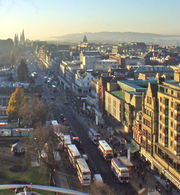
Boundaries date from 2005.
Twin and Partner cities
Edinburgh is twinned with several cities across the world:
Twin cities
- Aalborg, Denmark (1991)
- Dunedin, New Zealand (1974)
- Florence, Italy (1964)
- Kiev, Ukraine (1989)
- Munich, Germany (1954)
- Nice, France (1958)
- San Diego, United States (1977)
- Vancouver, Canada (1977)
- Xi'an, China (1985)
Partner cities
- Kraków, Poland (1995)
Friendship link
- Kyoto Prefecture, Japan (1994)
Transport
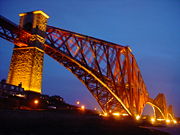
Edinburgh is a major transport hub in east central Scotland, with arterial road and rail routes that connect the city to the rest of Scotland and with England. It is connected to the north of Scotland by the famous feats of engineering, the Forth Bridge and the Forth Road Bridge.
Buses
Most public transport trips in Edinburgh are taken by bus, with Lothian Buses and First Bus operating an extensive system connecting most parts of the city, suburbs and surrounding city region.
Trams
Following a vote in the Scottish Parliament in June 2007, preliminary construction work (such as the diversion of utilities) has now started on the Edinburgh Tram Network, a light rapid transit tram line to connect Edinburgh Airport and Granton via the city centre and Leith Walk. Another loop may connect the city centre and the northern waterfront areas of Leith and Granton – areas which are undergoing major regeneration and redevelopment. Despite the reservations of First Minister Alex Salmond and the SNP minority Government, the project was voted through by the other parties in the Parliament.
Rail
Edinburgh Waverley is the main railway station for the city. It is on the East Coast Main Line and is a through-station as well as a terminus for many services to and from London Kings Cross operated by NXEC and to London Euston operated by Virgin Trains and First ScotRail, as well as services from within Scotland operated by First ScotRail. Haymarket Station is a smaller station located to the west of the city centre. The rail network in the city has expanded in recent years with the opening of Crossrail, from Newcraighall and Musselburgh in the east, to Curriehill, Edinburgh Park and Dalmeny in the west. The network is set to expand further with a new parkway station being constructed at Gogar for Edinburgh Airport and the electrification of the Haymarket - Edinburgh Park/Airport section in connection with the Airdrie - Bathgate Rail Link. Edinburgh and the East of Scotland's rail network are controlled from Edinburgh Signalling Centre, which with 240 route miles (470 track miles) has the largest control area in Europe. This will increase on completion of the Bathgate - Airdrie and Edinburgh - Galashiels rail lines which will also be controlled from Edinburgh.
Airport
Edinburgh is served by Edinburgh Airport (EDI), located about 8 miles (13 km) to the west of the city, with scheduled connections to many cities in Europe and an expanding international long-haul route network, including daily flights to New York (JFK and Newark) and summer services to Toronto. Construction of an underground rail link to the airport had been due to commence in 2007 and be operational by 2009, however the project was amended by the SNP government in September 2007, in favour of a surface interchange at a new station at Gogar to the proposed Edinburgh Tram Network.
Cycling
Attempts to make Edinburgh more "cycle friendly" have been made, particularly by Spokes, the Lothian Cycle Campaign. Some cyclists remain unconvinced that the promise of a "Model Cycle-Friendly City" has been achieved.
World-record holder
In April 2008 Mark Beaumont, from New Town, Edinburgh, broke the world record for the fastest circumnavigation of the globe by bicycle, completing his ride in only 194 days and 17 hours. BBC Scotland produced a four part documentary titled "The Man Who Cycled The World".
Thefts
Cycle thefts are common in the city, with an average of five bikes being stolen every day. Ian Maxwell, a member of Spokes Lothian Cycle Campaign, said: "We've seen a massive increase in cycling in Edinburgh over the last ten years and, unfortunately, with that trend comes an inevitable rise in thefts. Overall, though, with tens of thousands of cyclists, the numbers are still relatively low. The figures underline the problem of lack of secure parking facilities for bikes. They can be difficult to find. Cyclists need to take the appropriate precautions. These are opportunist thieves who move quickly and disappear on their newly acquired getaway vehicle."
Safety
Lothians roads are the most dangerous in Scotland for cyclists, with 165 cyclists a year being hospitalised. One common complaint is that cycle lanes are often placed inside bus lanes on some of the major roads in central Edinburgh, such as Princes Street and Lothian Road. This irritates bus drivers, who are limited by the slow speed of cyclists, and therefore feel compelled to perform unsafe vehicle manoeuvres like tailgating only inches behind cyclists, and overtaking when the outer lane is occupied so the bus cannot actually move around the cyclist safely, thus squeezing the cyclist between the bus and pavement. It is also common for cars and other vehicles to be parked in cycle lanes, forcing cyclists to weave in and out of lanes of traffic, to the irritation of other drivers.
Several cyclists have been killed in Edinburgh. In September 2004, a 28 year old man was killed by the driver of a Vauxhall Vectra at the junction of Marchmont Road and Melville Drive. In April 2008, a male cyclist was killed in a collision with a truck on the junction between West Richmond Street and Nicolson Street. The deceased was identified as Dr Iain Wilson, 35 years old, and an award winning neuroscientist who worked at the University of Edinburgh. A female student cyclist was killed in a collision with a bus on Marchmont Road in the late 90s.
Disputes
Pedicabs are a common form of transport for weekend revellers, with the number operating in Edinburgh growing from only 2 in 2000 to 60 by 2008. This has led to a growing number of complaints from taxi cab drivers, who resent the competition. In one dispute, a pedicab cyclist was reported to have been attacked by a group of three taxi drivers, who kicked and headbutted him. In other cases, taxi drivers have thrown cigarette butts at pedicab cyclists, and in one case, threatened a cyclist with a Taser stun gun (possession of such a device is illegal in Scotland).
Cycling in certain public parks, like walkways across the Meadows, is currently illegal. Under the Land Reform Act of 2003, park paths may be opened up to cyclists, but concerns have been expressed that cyclists may run pedestrians over. Peng Lee Yap, chairman of Friends of the Meadows, said "While this is clearly a difficult issue, it was felt that the positive way forward is the approach of Spokes to improve cyclists' behaviour." In late 2007 Spokes Lothian group launched their "Bike Polite" campaign to encourage cyclists to be more considerate.
Park and Ride
A new park and ride site was opened on February 3, 2008 at Sheriffhall, in addition to facilities at Ingliston, Riccarton, Fife and Newcraighall.
For all other park and ride information visit: The National Park and Ride Directory
Congestion
Traffic congestion, especially at peak times, is viewed as a problem. The rise in car use in the city caused commuting trips to grow by 72% in Edinburgh between 1981 and 2001. Various initiatives have been put in place to combat this, with "Greenways", dedicated bus lanes on primary routes into the city centre with strict traffic regulations, have been initiated in recent years. Improvements to the bus network have included guided busways in the west of the city and major improvements to bus services, such as clearer ticketing arrangements and better provision of bus stops. In 2005 Edinburgh Council's proposed congestion charging scheme was overwhelmingly rejected in a referendum.

Education
Universities and colleges
The University of Edinburgh was founded by Royal Charter in 1583, and is the fourth oldest university in Scotland, after St Andrews, Glasgow and Aberdeen. The Old College on South Bridge opened in the 1820s. As the institution continued to expand, new buildings were constructed around George Square, where the heart of the university remains, and the King's Buildings campus in southern Edinburgh. A third campus at Little France was established in 2002. Development of the University's estate continues on all three campuses in the 21st century.
The Royal College of Surgeons of Edinburgh and the Royal College of Physicians of Edinburgh were established by Royal Charter, in 1506 and 1681 respectively. The Trustees Drawing Academy of Edinburgh was established in 1760, an institution that became the Edinburgh College of Art in 1907.
In the 1960s Heriot-Watt University and Napier Technical College were established. Heriot-Watt traces its origins to 1821, when a school for technical education of the working classes was opened. Heriot-Watt continues to have a strong reputation in engineering, and is based at Riccarton, in the west of the city.
Napier College, renamed Napier Polytechnic in 1986, gained university status in 1992. Napier University has several campuses in the south and west of the city, including the former Craiglockhart Hydropathic (of Siegfried Sassoon and Wilfred Owen fame) and Merchiston Tower (the family home of John Napier). The University contains several specialised research centres (including the Centre for Timber Engineering, the International Teledemocracy Centre and a large business school. In 2005 the University secured Skillset Screen Academy status for its film courses and now operates (in conjunction with Edinburgh College of Art) the Screen Academy Scotland, one of six accredited centres in the UK.
Queen Margaret University was founded in 1875 as a women's college, and today specialises in healthcare, theatre, media, hospitality and business.
Other colleges offering further education in Edinburgh include Telford College, opened in 1968, and Stevenson College, opened in 1970. Basil Paterson College offers courses in languages and teaching. The Scottish Agricultural College also has a campus in south Edinburgh.
Schools
- List of Edinburgh Schools
Edinburgh schools include Donaldson's College and the Royal Blind School, Scotland’s national residential and day schools for deaf and blind students, both of which serve Scotland and the north east of England. The Royal High School is considered to be the oldest school in Scotland.
Edinburgh also has several independent schools including: Stewart's Melville College, The Mary Erskine School, George Heriot's School, Merchiston Castle School, George Watson's College, St George's School For Girls Loretto School, Edinburgh Academy, and Fettes College.
Hospitals
- List of hospitals in Edinburgh
Hospitals in Edinburgh include the Royal Infirmary of Edinburgh, which includes Edinburgh University Medical School, and the Western General Hospital, which includes a large cancer treatment centre. There is one private hospital, Murrayfield Hospital, owned by Spire Healthcare. The Royal Infirmary is the main Accident & Emergency hospital not just for Edinburgh but also Midlothian and East Lothian, and is the headquarters of NHS Lothian, making it a centric focus for Edinburgh and its hinterland. The Royal Edinburgh Hospital specialises in mental health, it is situated in Morningside. The Royal Hospital for Sick Children is located in Sciennes Road; it is popularly known as the 'Sick Kids'.
Religious communities
Christianity
The Church of Scotland claims the largest membership of any religious denomination in Edinburgh. Its most important and historical church is St Giles' Cathedral; others include Greyfriars Kirk, Barclay Church, Canongate Kirk and St Andrew's and St George's Church. In the south east of the city is the 12th century Duddingston Kirk. The Church of Scotland Offices are located in Edinburgh, as is the Assembly Hall and New College on The Mound.
The Roman Catholic Church also has a sizeable presence in the city. Its notable structures include St Mary's Cathedral at the top of Leith Walk, the Sacred Heart of Jesus, St Patrick's, St. Columba's, St. Peter's and Star of the Sea. The Catholic community in Edinburgh is part of the Archdiocese of St Andrews and Edinburgh, which is led by Keith Cardinal O'Brien, considered to be the leader of the Catholic Church in Scotland.
The Free Church of Scotland (Reformed and Presbyterian) has congregations on the Royal Mile and Crosscauseway; its offices and training college are located on the Mound. The Scottish Episcopal Church is part of the Anglican Communion. Its centre is the resplendent St Mary's Cathedral, Palmerston Place in the west end.
In addition, there are a number of independent churches situated throughout the city; these churches tend to have a high percentage of student congregants and include Destiny Church, Charlotte Chapel, Carrubbers Christian Centre and Bellevue Chapel.
Other faiths
Edinburgh Central Mosque - Edinburgh's main mosque and Islamic Centre is located on Potterow on the city's southside, near Bristo Square. It was opened in the late 1990s and the construction was largely financed by a gift from King Fahd of Saudi Arabia. The first recorded presence of a Jewish community in Edinburgh dates back to the late 17th century. Edinburgh's Orthodox synagogue is located in Salisbury Road, which was opened in 1932 and can accommodate a congregation of 2000. A Liberal congregation also meets in the city.
Notable residents
Famous authors of the city include Sir Arthur Conan Doyle, the creator of Sherlock Holmes, Ian Rankin, author of the Inspector Rebus series of crime thrillers, J. K. Rowling, the author of Harry Potter, who wrote her first book in an Edinburgh coffee shop ( Nicolson's Cafe, the Elephant House and Black Medicine) and Adam Smith, economist, born in Kirkcaldy, and author of The Wealth of Nations.
Edinburgh has been home to the actor Sir Sean Connery, famed as the first cinematic James Bond; Ronnie Corbett, a comedian and actor, best known as one of The Two Ronnies; and Dylan Moran, the Irish comedian. Famous city artists include the portrait painters Sir Henry Raeburn, Sir David Wilkie and Allan Ramsay. Historians such as Douglas Johnson and Arthur Marwick had roots here.
The city has produced or been home to musicians that have been extremely successful in modern times, particularly Ian Anderson, frontman of the band Jethro Tull; Wattie Buchan, lead singer and founding member of punk band The Exploited; Shirley Manson, lead singer for the band Garbage; The Proclaimers, a musical ensemble of two brothers; the Bay City Rollers; Boards of Canada and Idlewild.
Edinburgh is the hometown of the former Prime Minister of the United Kingdom, Tony Blair, who was born in the city and attended Fettes College; Robin Harper the co-convener of the Scottish Green Party; and John Witherspoon, the only clergyman to sign the United States Declaration of Independence, and later president of Princeton University.
On the more sinister side, famous criminals from Edinburgh's history include Deacon Brodie, pillar of society by day and burglar by night, who is said to have influenced Robert Louis Stevenson's story, the Strange Case of Dr Jekyll and Mr Hyde; the murderers Burke and Hare, who provided fresh corpses for anatomical dissection; and Major Weir a notorious warlock.
Scotland has a rich history of science and Edinburgh has its fair share of famous names. James Clerk Maxwell, the founder of the modern theory of electromagnetism, was born here and educated at the Edinburgh Academy, as was the telephone pioneer Alexander Graham Bell. Other names connected to the city include Max Born, physicist and Nobel laureate; Charles Darwin, the biologist who discovered natural selection; David Hume a philosopher, economist and historian; James Hutton, regarded as the "Father of Geology"; John Napier inventor of logarithms; and Ian Wilmut the geneticist involved in the cloning of Dolly the sheep just outside Edinburgh. The stuffed carcass of Dolly the sheep is now on display in the National Museum of Scotland.
Sister cities
Edinburgh has several sister cities:
 Munich, Germany.
Munich, Germany. Nice, France.
Nice, France. Florence, Italy.
Florence, Italy. Dunedin, New Zealand.
Dunedin, New Zealand. Vancouver, Canada.
Vancouver, Canada. San Diego, California, United States.
San Diego, California, United States. Xi'an, China.
Xi'an, China. Kiev, Ukraine.
Kiev, Ukraine. Aalborg, Denmark.
Aalborg, Denmark. Ordu, Turkey.
Ordu, Turkey.
